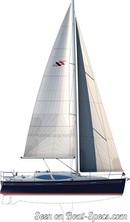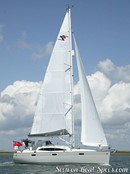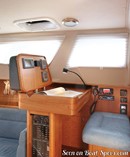Southerly 330
Sailboat specifications
The Southerly 330 is a 32’8” (9.97m) cruising sailboat designed by Stephen Jones Yacht Design (United Kingdom). She was built between 2017 and 2019 by Discovery Yachts Group (United Kingdom).
The Southerly 330 has also been marketed as Southerly 32.
The Southerly 330 has also been marketed as Southerly 32.
Southerly 330's main features
- Model
- Southerly 330
- Hull type
- Monohull
- Category
- Cruising sailboat
- Sailboat builder
- Sailboat designer
- Sailboat range
- Country
- United Kingdom
- Construction
- GRP (glass reinforced polyester):
Single skin bottom, sandwich sides and deck: fiberglass vinylester vacuum bagged - First built hull
- 2017
- Last built hull
- 2019
- Appendages
- Lifting keel : swing keel
- Helm
- Single helm wheel
- Rudder
- Twin spade rudders
- Unsinkable
- No
- Trailerable
- No
- EC design categoryiThe CE design category indicates the ability to cope with certain weather conditions (the sailboat is designed for these conditions)
A: Wind < force 9, Waves < 10m
B: Wind < force 8, Waves < 8m
C: Wind < force 6, Waves < 4m
D: Wind < force 4, Waves < 0,5m - A
- Standard public price ex. VAT (indicative only)
- About213 000 €(2017)
Southerly 330's main dimensions
- Hull length
- 32’ 8”9.97 m
- Waterline length
- 28’ 11”8.8 m
- Beam (width)
- 11’ 10”3.6 m
- Draft
- 7’ 5”2.26 m
- Draft when appendages up
- 2’ 8”0.83 m
- Mast height from DWL
- 54’ 6”16.6 m
- Light displacement (MLC)
- 16438 lb7456 kg
- Ballast weight
- 6113 lb2773 kg
- Ballast type
- Cast iron
Southerly 330's rig and sails
- Upwind sail area
- 710 ft²66 m²
- Downwind sail area
- 872 ft²81 m²
- Mainsail area
- 355 ft²33 m²
- Genoa area
- 355 ft²33 m²
- Jib area
- 215 ft²20 m²
- Gennaker area
- 517 ft²48 m²
- Rigging type
- Sloop Marconi 7/8
- Mast configuration
- Deck stepped mast
- Rotating spars
- No
- Number of levels of spreaders
- 2
- Spreaders angle
- Swept-back
- Spars construction
- Aluminum spars
Southerly 330's performances
- Upwind sail area to displacementiThe ratio sail area to displacement is obtained by dividing the sail area by the boat's displaced volume to the power two-thirds.
The ratio sail area to displacement can be used to compare the relative sail plan of different sailboats no matter what their size.
Upwind: under 18 the ratio indicates a cruise oriented sailboat with limited performances especially in light wind, while over 25 it indicates a fast sailboat. - 186 ft²/T17.29 m²/T
- Downwind sail area to displacementiThe ratio sail area to displacement is obtained by dividing the sail area by the boat's displaced volume to the power two-thirds.
The ratio sail area to displacement can be used to compare the relative sail plan of different sailboats no matter what their size. - 228 ft²/T21.22 m²/T
- Displacement-length ratio (DLR)iThe Displacement Length Ratio (DLR) is a figure that points out the boat's weight compared to its waterline length. The DLR is obtained by dividing the boat's displacement in tons by the cube of one one-hundredth of the waterline length (in feet).
The DLR can be used to compare the relative mass of different sailboats no matter what their length:
a DLR less than 180 is indicative of a really light sailboat (race boat made for planning), while a DLR greater than 300 is indicative of a heavy cruising sailboat. - 310
- Ballast ratioiThe Ballast ratio is an indicator of stability; it is obtained by dividing the boat's displacement by the mass of the ballast. Since the stability depends also of the hull shapes and the position of the center of gravity, only the boats with similar ballast arrangements and hull shapes should be compared.
The higher the ballast ratio is, the greater is the stability. - 37 %
- Righting moment @ 30°iThe righting moment is a moment (torque) that tends to restore a boat to its previous position after heeling. Its value corresponds to the torque needed to heel the boat for this angle.
Higher the righting moment is for an angle, greater is the stability. - 21120 lb.ft2920 kg.m
- Maximum righting momentiThe righting moment is a moment (torque) that tends to restore a boat to its previous position after heeling. Its value corresponds to the torque needed to heel the boat for this angle.
Higher the righting moment is for an angle, greater is the stability. - 32259 lb.ft4460 kg.m @ 53.00 °
- Critical hull speediAs a ship moves in the water, it creates standing waves that oppose its movement. This effect increases dramatically the resistance when the boat reaches a speed-length ratio (speed-length ratio is the ratio between the speed in knots and the square root of the waterline length in feet) of about 1.2 (corresponding to a Froude Number of 0.35) . This very sharp rise in resistance, between speed-length ratio of 1.2 to 1.5, is insurmountable for heavy sailboats and so becomes an apparent barrier. This leads to the concept of "hull speed".
The hull speed is obtained by multiplying the square root of the waterline length (in feet) by 1.34. - 7.20 knots
Southerly 330's auxiliary engine
- Engine(s)
- 1 inboard engine
- Engine(s) power
- 29 HP
- Fuel type
- Diesel
- Fuel tank capacity
- 36.2 gal137 liters
Southerly 330's accommodations and layout
- Cockpit
- Closing aft cockpit with opening system
- Cabin(s)
- 2
- Berth(s) (min./max.)
- 4 / 6
- Head(s)
- 1
- Freshwater tank capacity
- 43.6 gal165 liters
- Fridge/ice-box capacity
- 19.8 gal75 liters


Discovery Yachts Group Southerly 330 - - 1/12
Picture extracted from the commercial documentation © Discovery Yachts Group
Picture extracted from the commercial documentation © Discovery Yachts Group


Discovery Yachts Group Southerly 330 sailplan - - 2/12
Picture extracted from the commercial documentation © Discovery Yachts Group
Picture extracted from the commercial documentation © Discovery Yachts Group


Discovery Yachts Group Southerly 330 layout - - 3/12
Picture extracted from the commercial documentation © Discovery Yachts Group
Picture extracted from the commercial documentation © Discovery Yachts Group


Discovery Yachts Group Southerly 330 sailing - - 4/12
Picture extracted from the commercial documentation © Discovery Yachts Group
Picture extracted from the commercial documentation © Discovery Yachts Group


Discovery Yachts Group Southerly 330 sailing - - 5/12
Picture extracted from the commercial documentation © Discovery Yachts Group
Picture extracted from the commercial documentation © Discovery Yachts Group


Discovery Yachts Group Southerly 330 sailing - - 6/12
Picture extracted from the commercial documentation © Discovery Yachts Group
Picture extracted from the commercial documentation © Discovery Yachts Group


Discovery Yachts Group Southerly 330 sailing - - 7/12
Picture extracted from the commercial documentation © Discovery Yachts Group
Picture extracted from the commercial documentation © Discovery Yachts Group


Discovery Yachts Group Southerly 330 interior and accommodations - - 8/12
Picture extracted from the commercial documentation © Discovery Yachts Group
Picture extracted from the commercial documentation © Discovery Yachts Group


Discovery Yachts Group Southerly 330 interior and accommodations - - 9/12
Picture extracted from the commercial documentation © Discovery Yachts Group
Picture extracted from the commercial documentation © Discovery Yachts Group


Discovery Yachts Group Southerly 330 interior and accommodations - - 10/12
Picture extracted from the commercial documentation © Discovery Yachts Group
Picture extracted from the commercial documentation © Discovery Yachts Group


Discovery Yachts Group Southerly 330 interior and accommodations - - 11/12
Picture extracted from the commercial documentation © Discovery Yachts Group
Picture extracted from the commercial documentation © Discovery Yachts Group


Discovery Yachts Group Southerly 330 interior and accommodations - - 12/12
Picture extracted from the commercial documentation © Discovery Yachts Group
Picture extracted from the commercial documentation © Discovery Yachts Group
Similar sailboats that may interest you:
Sailboats
First built hull
Hull length
1966
33’ 5”10.18 m
1986
30’ 11”9.42 m
2007
32’ 8”9.97 m
1991
34’ 4”10.44 m
1971
30’9.14 m
1985
32’ 10”10 m
2017
32’ 10”9.99 m
2014
30’ 8”9.35 m
2014
32’ 8”9.98 m
2014
32’ 10”9.99 m
1967
33’ 1”10.1 m
2013
32’ 8”9.97 m
1978
34’ 7”10.54 m
2006
34’ 10”10.6 m
2007
35’ 6”10.82 m